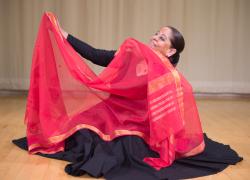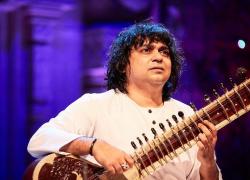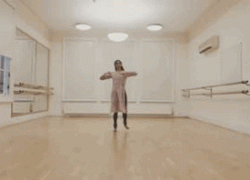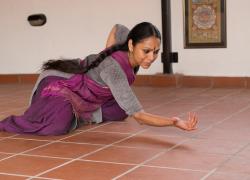Can This Place Be A Temple? – Akshay Sharma
Can This Place Be A Temple?
Akshay Sharma
Tuesday 3 October
The Place, London
Reviewed by Maryam Shakiba
A mist hung in the air, gently illuminated with warm light against the bare backdrop of the black stage.
Akshay Sharma emerged into the space, his stature strong and solid, and spoke to us of mythical tales; a goddess holding both zero and infinity in her palms. His words, sensitively weighted in their delivery, invited us into this liminal space of his creation.
Textures of gold. Sharma’s beige silk shirt, a metallic foil sheet he stretched across the floor, glowing yellow lights.
Akshay Sharma is an independent choreographer and performer born and brought up in India, and is now based in London where he moved after graduating from Northern School of Contemporary Dance. As well as his dance and writing practice, he has also been developing a form of lyrical composition for movement where he applies the structures and approach of the Hindustani classical tradition of Dhrupad to his choreographic practice.
While I had been expecting an element of live singing as part of the piece, I have to admit I was expecting the involvement of another artist to deliver this element of the work. When Sharma himself started exploring vocalisation in the deeply meditative Dhrupad style, it was an exciting development. His voice was full-bodied and grounded, patiently exploring the raga.
When watching Indian classical singing performances, we often see how the body and hands are used to support drawing out the intricacies of vocal technique, and support movement through a melodic framework. It was a pleasure to watch Sharma as he built the connection between his body and his voice, vocals and movement entwining ever deeper as the work developed.
This deep connection between music and movement became a core theme running through the piece. As the soundscape moved to incorporate a minimal percussive score, we watched as Sharma’s movements encompassed his whole body, arms whirling and propelling him across the stage in intricate flurries.
There were some clear highlights in the piece, punctuated by a musical score that took us on a journey across continents and cultures. Western choral music was invoked in a particularly visually mesmerising segment (no spoilers as it was really magical!), and electronic music under a luminous pink light of a disco ball, which had Sharma careening around the space before emerging in a stark light, as if it was the morning after the wild night before.
Sharma’s movements, his use of speed and dynamics, and the assuredness with which he moved around the space, were beautiful to watch. It did feel that there was scope for further development of movement material to hit some higher emotional notes. However, the vocabulary had an organic quality to it, and did not try and impose virtuosity, which was also welcoming. It is hard to find an authentic balance that satisfies a hungry audience!
The sense of the piece overall; in terms of set design, music and movement; was minimalist, which allowed the various segments to shine with clarity. The piece states to touch on 'themes of race, gender, migration and nature', and this was definitely achieved.
An argument could be made for maybe touching on fewer themes to find a clearer overall arc, as at times it wasn’t easy to navigate the piece… but maybe that then wouldn’t reflect the multifaceted nature of life. I also really appreciated Sharma’s curiosity for the world he inhabits, both imposed on him and sought out by him; and by nature, it is a multitude of worlds colliding. This piece tries to make sense of that, through a deliberate and considered approach.
Congratulations Akshay on a fantastic piece of work – I look forward to seeing and experiencing more of your ever-evolving and multifaceted journey!
Next performance: 26 October, Kala Sangam, Bradford.
Maryam Shakiba is a London-based performing artist.



















